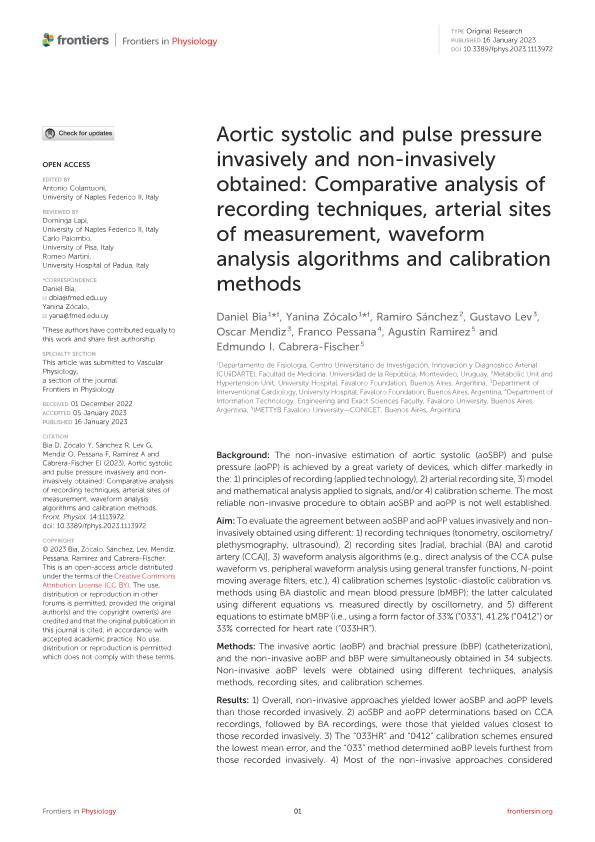Artículo
Aortic systolic and pulse pressure invasively and non-invasively obtained: Comparative analysis of recording techniques, arterial sites of measurement, waveform analysis algorithms and calibration methods
Bia, Daniel; Zócalo, Yanina; Sánchez, Ramiro; Lev, Gustavo; Mendiz, Oscar; Pessana, Franco Martin; Ramírez, Agustín José ; Cabrera Fischer, Edmundo Ignacio
; Cabrera Fischer, Edmundo Ignacio
 ; Cabrera Fischer, Edmundo Ignacio
; Cabrera Fischer, Edmundo Ignacio
Fecha de publicación:
01/2023
Editorial:
Frontiers Media
Revista:
Frontiers in Physiology
e-ISSN:
1664-042X
Idioma:
Inglés
Tipo de recurso:
Artículo publicado
Clasificación temática:
Resumen
Background: The non-invasive estimation of aortic systolic (aoSBP) and pulse pressure (aoPP) is achieved by a great variety of devices, which differ markedly in the: 1) principles of recording (applied technology), 2) arterial recording site, 3) model and mathematical analysis applied to signals, and/or 4) calibration scheme. The most reliable non-invasive procedure to obtain aoSBP and aoPP is not well established. Aim: To evaluate the agreement between aoSBP and aoPP values invasively and non-invasively obtained using different: 1) recording techniques (tonometry, oscilometry/plethysmography, ultrasound), 2) recording sites [radial, brachial (BA) and carotid artery (CCA)], 3) waveform analysis algorithms (e.g., direct analysis of the CCA pulse waveform vs. peripheral waveform analysis using general transfer functions, N-point moving average filters, etc.), 4) calibration schemes (systolic-diastolic calibration vs. methods using BA diastolic and mean blood pressure (bMBP); the latter calculated using different equations vs. measured directly by oscillometry, and 5) different equations to estimate bMBP (i.e., using a form factor of 33% (“033”), 41.2% (“0412”) or 33% corrected for heart rate (“033HR”). Methods: The invasive aortic (aoBP) and brachial pressure (bBP) (catheterization), and the non-invasive aoBP and bBP were simultaneously obtained in 34 subjects. Non-invasive aoBP levels were obtained using different techniques, analysis methods, recording sites, and calibration schemes. Results: 1) Overall, non-invasive approaches yielded lower aoSBP and aoPP levels than those recorded invasively. 2) aoSBP and aoPP determinations based on CCA recordings, followed by BA recordings, were those that yielded values closest to those recorded invasively. 3) The “033HR” and “0412” calibration schemes ensured the lowest mean error, and the “033” method determined aoBP levels furthest from those recorded invasively. 4) Most of the non-invasive approaches considered overestimated and underestimated aoSBP at low (i.e., 80 mmHg) and high (i.e., 180 mmHg) invasive aoSBP values, respectively. 5) The higher the invasively measured aoPP, the higher the level of underestimation provided by the non-invasive methods. Conclusion: The recording method and site, the mathematical method/model used to quantify aoSBP and aoPP, and to calibrate waveforms, are essential when estimating aoBP. Our study strongly emphasizes the need for methodological transparency and consensus for the non-invasive aoBP assessment.
Archivos asociados
Licencia
Identificadores
Colecciones
Articulos (IMETTYB)
Articulos de INSTITUTO DE MEDICINA TRASLACIONAL, TRASPLANTE Y BIOINGENIERIA
Articulos de INSTITUTO DE MEDICINA TRASLACIONAL, TRASPLANTE Y BIOINGENIERIA
Citación
Bia, Daniel; Zócalo, Yanina; Sánchez, Ramiro; Lev, Gustavo; Mendiz, Oscar; et al.; Aortic systolic and pulse pressure invasively and non-invasively obtained: Comparative analysis of recording techniques, arterial sites of measurement, waveform analysis algorithms and calibration methods; Frontiers Media; Frontiers in Physiology; 14; 1113972; 1-2023; 1-21
Compartir
Altmétricas



